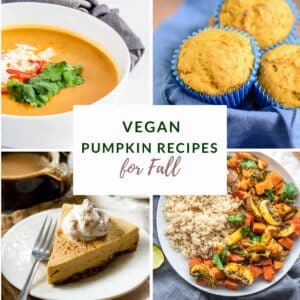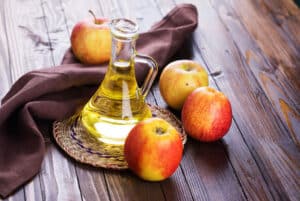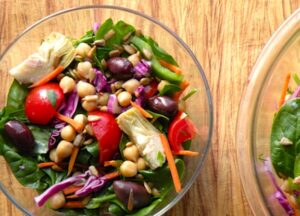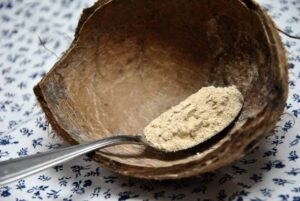Those little jars of prepared garlic and ginger are so completely convenient! No fussing with paper-thin garlic peels, no paring gnarly knobs of ginger or endangering fingers on the ginger grater and no garlic-smelling hands for the rest of the night. But is it OK to use these conveniences?
I get this question a lot, usually phrased a little sheepishly, as if the questioner is already using the bottled stuff; she just wants to know how guilty she should feel. After all, what kind of cook doesn’t peel, mince and grate her own ginger and garlic?
One of the fun things about my cooking classes is that we actually experiment with fancier ingredients and preparation methods, do side-by-side taste comparisons, and see whether they are worth the extra time and money. This month we pitted prepared garlic and ginger against fresh, in an easy version of Saag Paneer.
The results? The dish with fresh ginger and garlic really did taste better. “Brighter” you might say. You could really pick up on the tangy-ness of the ginger and earthiness of the garlic. So yes, peeling, chopping and grating your own does make a difference. But does that answer the question of whether it’s OK to use prepared stuff? Not exactly.
Even though I know flavor might be sacrificed, I use prepared ginger and garlic all the time because sometimes, flavor isn’t the only factor to consider. How much of a flavor difference is there? Will it make a difference in the dish I’m making? What if I’m so pressed for time that a flavor/convenience tradeoff is acceptable? And finally, do I care?
In our Saag Paneer class, for example, one participant acknowledged that fresh tasted better—but not enough to offset the convenience of the prepared version! She was perfectly happy with the taste of her dish, which is the real bottom line and the answer to our question. As long as you are OK with a tradeoff in taste, then pre-chopped ginger and garlic are completely OK.
Sure, a five-star chef wouldn’t use prepared ginger and garlic, but she has a sous chef to do her grating and chopping! For everyday cooks, the prepared products can be a real godsend, making good-enough dishes possible on a busy schedule.
Personally, I favor a selective use of prepared garlic and ginger. Rather than completely embracing or shunning them, I follow this rough rule: The longer garlic and ginger are cooked in a dish, the less they are the dominant flavor, and the less time I have, the more I am inclined to use the prepared versions. Conversely, in recipes where garlic or ginger is used uncooked or only lightly cooked, or where it is the main flavor, I am inclined to use fresh unless I absolutely don’t have time.
Here are some specifics to flesh out that general rule:
Mary’s Six Guidelines for Fresh vs. Prepared
1. Cooking Time When garlic or ginger is used in an uncooked form, as in a pesto or salad dressing, I use fresh, no question. Ditto for dishes where the garlic or ginger is only lightly cooked, as in Spinach with Raisins and Pine Nuts (check it out at the Vegetable a Month Club). In these cases, flavor is critical. What’s more, when used fresh, very little is required, minimizing prep time.
On the other hand,if garlic is called for in a long-simmering stew, I usually opt for prepared, since the flavor difference becomes almost imperceptible with longer cooking times. For in-between dishes, like stir-fries and skillets, I let time dictate my choice.
2. Flavor Dominators When garlic or ginger is the predominant flavor in a dish, I am sure to use fresh. If the flavorings are just a side note, however, I feel fine substituting the prepared versions, as when I make nut burgers, which combine a myriad of flavors.
3. Backup Plan What if the flavor of fresh is needed, but there just isn’t time to chop and grate? Two solutions: Use a little more and/or cook it a little less, to keep the flavors bright.
4. A Continuum Perspective Any time a convenience food question comes up, I view it from a “Continuum Perspective.” In other words, I imagine the possible range of foods positioned along a continuum. On one end are highly processed and refined packaged foods without much in the way of nutritional value to recommend them. At the other end are nutritional darlings like fresh fruits and vegetables, whole grains, lean proteins, good fats, and so on.
Of course it would be ideal to eat completely from the whole, natural, fresh and from-scratch end of the continuum, but I pat myself on the back if I at least keep progressing along towards the ideal. So if at times I must rely on some canned beans—or pre-chopped ginger and garlic—to get a decent meal on the table, I don’t hesitate for a second. I’m still further along the continuum than if I tried to cook completely from scratch, got overwhelmed and ended up making a packaged and processed something out of desperation.
5. At Least Try Fresh Once Remember what your mother said when you turned up your nose at dinner? “How will you know unless you try?” I used to think that bottled lemon juice was a good enough substitute for fresh—because I had never bothered to squeeze my own. Finally I put out the effort and tried fresh. I was fully humbled and corrected. So at least try the fresh stuff a couple times so you have a point of reference–and know if you’re missing out on something.
6. Read the Ingredient Label Everything said so far is based on the assumption that your pre-chopped ginger or garlic (or other convenience food) is just that: “ginger” and “garlic.” Surprisingly, this is often not the case. Reading the ingredient label is the only way to know if a seemingly simple food contains additives, colorings, preservatives, excessive amounts of salt and so on. If it does, using it isn’t just a matter of taste, but also a matter of personal health.
The Bottom Line: They may be completely convenient, but real cooks can use pre-chopped ginger and garlic–without feeling guilty!
Mary Collette Rogers is the author of Take Control of Your Kitchen.* In addition to writing, she offers kitchen makeover services, meal planning consultations, and classes on healthy cooking, in the hope of sharing her practical KitchenSmart habits and tools so busy people everywhere can enjoy wonderfully delicious and nourishing meals. Visit her at Everyday Good Eating.
- For lots more features on healthy lifestyle, explore VegKitchen’s Healthy Vegan Kitchen page.
*This post contains affiliate links. If the product is purchased by linking through this review, VegKitchen receives a modest commission, which helps maintain our site and helps it to continue growing!






gail stonebraker says
when useing jar garlic should you use the juice or should you strain the minced pieces?
Nava says
Gail, you can just toss them in as is to a soup or stew, but if you want to sauté them in olive oil, you'll want to strain them.
Darryl says
Thank you for your post. I enjoy eating garlic and ginger. Both are alkaline forming and healthy for the body. Powerful foods. Thank you again.
Sandra says
You'll be amazed how convenient and flavorful Spice World's "SQUEEZE GARLIC and SQUEEZE GINGER" are as a main ingredient in any dish. It gives the chef at home the ability to always have these two wonderful ingredients available without the time consumed peeling and chopping the fresh. In addition there is no waste as it's 100% useable and easy.
Lesley says
Can anyone tell me what the cost of fresh garlic and ginger in a jar costs?